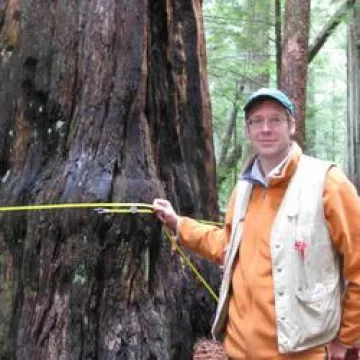Rethinking Forest Resiliency to High-Intensity Wildfires
This profile is a part of our consortium profile series, highlighting the people that make up the SW CASC—what inspires them, makes them passionate about their research, and gives them hope for the future. For this profile, Bryson Mineart (SW CASC communications student assistant and undergraduate student in the University of Arizona Computer Science program) interviewed USGS Research Ecologist, Phil van Mantgem, Redwood Field Station at Arcata, California.

Phil van Mantgem is a USGS research ecologist whose focus stems from a deep-rooted passion for nature and the urgency of climate change. As a researcher, Phil is always trying to find the best, no-regret conservation strategies for managers to take in response to our changing climate. The information that Phil collects is used by numerous management agencies to make informed decisions. Outside of his career, Phil still ventures out into nature to recharge and soak in the beauty of nature.
As an ecologist, Phil’s area of research includes any and all conifer forests in the western United States. If it is in California and has trees, then Phil is likely interested. Phil’s career began in the small state of Iowa where he was conducting intentional prairie burns in an effort to conserve the great prairies in the Midwest. From here, his career took a slight detour into wetland restoration research, through the Crane Foundation. Phil continued this research in California where he finally decided that he needed a change. So, he went on several backpacking trips around the western US, and with some help from his dissertation, Phil fell in love with the forestry in parts of California and Nevada. The rest is history as Phil began conducting research on giant sequoias and redwoods in California.
Much of Phil’s research is conducted in or around Redwood National Park, which naturally leads to him partnering with several environmental agencies. Essentially, Phil is willing and ready to work with any agency or person who is interested in redwood regeneration and growth. In the past, he has worked with park managers with the National Park Service and other forest management agencies. USGS scientist Nate Stephenson helped boost Phil's career. Nate generally concentrates on improving scientists’ and land managers’ ability to better prepare for and react to the effects of ongoing global changes. With Nate’s guidance and partnership, Phil has developed a strong foundation of important and fulfilling climate-related research that he hopes to continue into the future.
California, and several other western states, are experiencing high-intensity large wildfires unlike any experienced in recent history. These fires have reached an intensity high enough to harm giant sequoias and redwoods, which up until this point have responded positively to low-intensity fires. Thus, Phil sees great promise in research on post-fire habitats, including questions such as: How are forests responding to these big fires? Should there be human influence in this recovery period? If so, how much? These are the types of questions racing through Phil’s mind as he conducts his research. Phil believes that, in some instances, humans have a role to play in forest recovery, and that forests may also have more resiliency than we usually imagine. In fact, in his research, Phil has seen some surprising recovery and regeneration in areas with large fires. This has given Phil hope for the future of conifer forests in the western U.S..

